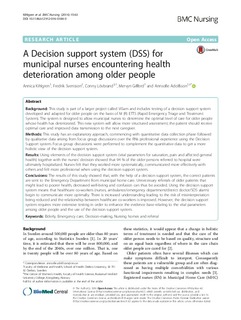| dc.contributor.author | Kihlgren, Annica | |
| dc.contributor.author | Svensson, Fredrik | |
| dc.contributor.author | Løvbrand, Conny | |
| dc.contributor.author | Gifford, Mervyn | |
| dc.contributor.author | Adolfsson, Annsofie | |
| dc.date.accessioned | 2018-02-23T10:34:13Z | |
| dc.date.available | 2018-02-23T10:34:13Z | |
| dc.date.created | 2016-11-29T19:46:14Z | |
| dc.date.issued | 2016 | |
| dc.identifier.citation | BMC Nursing. 2016, 15:63 | nb_NO |
| dc.identifier.issn | 1472-6955 | |
| dc.identifier.uri | http://hdl.handle.net/11250/2486701 | |
| dc.description.abstract | Background: This study is part of a larger project called ViSam and includes testing of a decision support system developed and adapted for older people on the basis of M (R) ETTS (Rapid Emergency Triage and Treatment System). The system is designed to allow municipal nurses to determine the optimal level of care for older people whose health has deteriorated. This new system will allow more structured assessment, the patient should receive optimal care and improved data transmission to the next caregiver. Methods: This study has an explanatory approach, commencing with quantitative data collection phase followed by qualitative data arising from focus group discussions over the RNs professional experience using the Decision Support system. Focus group discussions were performed to complement the quantitative data to get a more holistic view of the decision support system. Results: Using elements of the decision support system (vital parameters for saturation, pain and affected general health) together with the nurses' decision showed that 94 % of the older persons referred to hospital were ultimately hospitalized. Nurses felt that they worked more systematically, communicated more effectively with others and felt more professional when using the decision support system. Conclusions: The results of this study showed that, with the help of a decision support system, the correct patients are sent to the Emergency Department from municipal home care. Unnecessary referrals of older patients that might lead to poorer health, decreased well-being and confusion can thus be avoided. Using the decision support system means that healthcare co-workers (nurses, ambulance/emergency department/district doctor/SOS alarm) begin to communicate more optimally. There is increased understanding leading to the risk of misinterpretation being reduced and the relationship between healthcare co-workers is improved. However, the decision support system requires more extensive testing in order to enhance the evidence base relating to the vital parameters among older people and the use of the decision support system. | nb_NO |
| dc.language.iso | eng | nb_NO |
| dc.rights | Navngivelse 4.0 Internasjonal | * |
| dc.rights.uri | http://creativecommons.org/licenses/by/4.0/deed.no | * |
| dc.title | A Decision support system (DSS) for municipal nurses encountering health deteroriation among older people | nb_NO |
| dc.type | Journal article | nb_NO |
| dc.type | Peer reviewed | nb_NO |
| dc.description.version | publishedVersion | nb_NO |
| dc.rights.holder | The Authors | nb_NO |
| dc.source.volume | 15 | nb_NO |
| dc.source.journal | BMC Nursing | nb_NO |
| dc.identifier.doi | 10.1186/s12912-016-0184-0 | |
| dc.identifier.cristin | 1406101 | |
| cristin.unitcode | 222,56,1,0 | |
| cristin.unitname | Institutt for sykepleie- og helsevitenskap | |
| cristin.ispublished | true | |
| cristin.fulltext | original | |
| cristin.qualitycode | 1 | |

